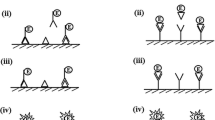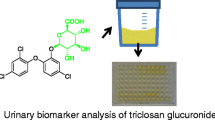Summary
A sensitive enzyme immunoassay method (EIA) for an anticancer drug, aclacinomycin A (ACM), has been developed.With a double-antibody technique, ACM at a concentration as low as 100 pg/tube can be detected. An antibody to ACM was obtained by immunizing rabbits with an antigen prepared by coupling ACM with mercaptosuccinylated bovine serum albumin via N-maleoyl aminobutyric acid (MABA) as a coupling agent. Enzyme labeling of ACM was performed withβ-D-galactosidae (β-Gal; EC 3.2.1.23) via m-maleoyl benzoic acid (MBA). The standard curve of the assay was linear on a logit-log plot over a concentrationrange of 30 pg to 10 ng. The antibody detected ACM and its metabolites, MA144 M1 (M1), MA144 N1 (N1), MA144 S1 (S1), and aklavin (T1) equally well, but was only minimally reactive with aklavinone (D1) and 7-deoxyaklavinone (C1), thus suggesting that this EIA can detect the total amounts of ACM and its biologically active glycosides among metabolites of ACM. This EIA is practically free from interference by any other anticancer drugs. Using this assay, serum levels of ACM equivalents can be determined accurately after administration of the drug to rats at a single dose of 10 mg/kg. Since ACM is now undergoing clinical trial, the EIA of the drug will be a valuable tool in clinical pharmacological studies.
Similar content being viewed by others
References
Anderson GW, Zimmerman JE, Callahan FM (1967) A reinvestigation of the mixed carbonic anhydride method of peptide synthesis. J Am Chem Soc 89:5012
Craven GR, Steers E, Anfinsen CB (1965) Purification, comparison, and molecular weight ofβ-D-galactosidase ofEscherichia coli K 12. J Biol Chem 240:2468
Egorin MJ, Van Echo DA, Whitacre MY, Fox BM, Aisner J, Wiernik PH, Bachur NR (1981) A phase 1 trial of aclacinomycin A. Proc AACR/ASCO 22:353
Egorin MJ, Echo DV, Fox BM, Whitacre M, Bachur NR (1982) Plasma kinetics of aclacinomycin A and its major metabolites in man. Cancer Chemother Pharmacol 8:41
Ellman GL (1962) Tissue sulfhydryl groups. Arch Biochem Biophys 82:70
Fujiwara K, Saikusa H, Yasuno M, Kitagawa T (1982) Enzyme immunoassay for the quantification of mitomycin C usingβ-galactosidase as a label. Cancer Res 42:1487
Fujiwara K, Asada H, Kitagawa T, Yamamoto K, Ito T, Tsuchiya R, Sohda M, Nakamura N, Hara K, Tomonaga Y, Ichimaru M, Takahashi S (1983) Preparation of polyamine antibody and its use in enzyme immunoassay of spermine and spermidine withβ-D-galactosidase as a label. J Immunol Methods 61:217
Furue H, Komita T, Nakao I, Furukawa I, Kanko T, Yokoyama T (1978) Clinical experiences with aclacinomycin-A. Recent Results Cancer Res 63:241
Hori S, Shirai M, Hirano S, Oki T, Inui T, Tsukagoshi S, Ishizuka M, Takeuchi T, Umezawa H (1977) Antitumor activity of new anthracycline antibiotics, aclacinomycin A and its analogs, and their toxicity. Gann 68:685
Iguchi H, Matsushita Y, Ohmori K, Hirano S, Kiyosaki T, Hori S, Tone H, Oki T (1980a) Studies on the absorption, excretion and distribution of aclacinomycin A: Absorption, excretion and distribution of aclacinomycin A in mice, rabbits, and dogs by photometric assay. Jpn J Antibiot [Suppl] 33:179
Iguchi H, Seryu Y, Kiyosaki T, Hori S, Tone T, Oki T (1980b) Studies on the absorption, excretion and distribution of14C- or3H-aclacinomycin A in mice and rabbits. Jpn J Antibiot [Suppl] 33:169
Kitagawa T, Aikawa T (1976) Enzyme coupled immunoassay of insulin using a novel coupling reagent. J Biochem (Tokyo) 79:233
Kitamura I, Oki T, Inui T (1978) A sensitive analytical method for aclacinomycin A and its analogs by thin-layer chromatography and fluorescence scanning. J Antibiot (Tokyo) 31:912
Klotz IM, Heiney RE (1959) Introduction of sulfhydryl groups into proteins using acetylmercaptosuccinic anhydride. Arch Biochem Biophys 82:70
Komiyama T, Oki T, Inui T (1979) A proposed reaction mechanism for the enzymatic reductive cleavage of glycosidic bond in anthracycline antibiotics. J Antibiot (Tokyo) 32:1219
Malspeis L, Neidhart J, Staubus A, Kear T, Booth J (1981) HPLC determination of aclacinomycin A (NSC 208734. ACM) in plasma and application to preliminary clinical pharmacokinetic studies. Proc Am Assoc Cancer Res 22:242
Matsuzawa Y, Kiyosaki T, Oki T, Takeuchi T, Umezawa H (1982) Radioimmunoassay for aclacinomycin A. Gann 73:229
Ogasawara T, Masuda Y, Goto S, Mori S, Oki T (1981) High performance liquid chromatographic determination of aclacinomycin A and its related compounds. II. Reverse phase HPLC determination of aclacinomycin A and its metabolities in biological fluids using fluorescence detection. J Antibiot (Tokyo) 34:52
Oki T (1977) New anthracycline antibiotics. J Antibiot (Tokyo) 30:570
Oki T (1980) New anthracycline antibiotics. Jpn J Antibiot [Suppl] 33:179
Oki T, Matsuzawa Y, Yoshimoto A, Numata K, Kitamura I, Hori S, Takamatsu A, Umezawa H, Ishizuka M, Naganawa H, Suda H, Hamada M, Takeuchi T (1975) New antitumor antibiotics, aclacinomycin A and B. J Antibiot (Tokyo) 28:830
Oki T, Takeuchi T, Oka S, Umezawa H (1980) Current status of Japanese studies with the new anthracycline antibiotic, aclacinomycin A. Recent Results Cancer Res 74:207
Oki T, Takeuchi T, Oka S, Umezawa H (1981) New anthracycline antibiotic aclacinomycin A: Experimental studies and corrections with clinical trials. Recent Results Cancer Res 76:21
Pal SB (ed) (1978) Enzyme-labelled immunoassay of hormones and drugs. Ulm, West Germany. de Gruyter, Berlin New York
Rich DH, Gesellchen PD, Tong A, Cheung A, Buckner CK (1975) Alkylating derivatives of amino acids and peptides. Synthesis ofN-maleoyl amino acids, [1-(N-maleoylglycyl)cysteinyl]oxytosin, and [1-(N-maleoyl-11-aminodecanoyl) cysteinyl] oxytosin. Effects on vasopressin-stimulated water loss from isolated toad bladder. J Med Chem 18:1004
Tanaka H, Yoshioka T, Shimauchi Y, Matsuzawa Y, Oki T, Inui T (1980) Chemical modification of anthracycline antibiotics. I. Demethoxycarbonylation, 10-epimerization and 4-0-methylation of aclacinomycin A. J Antibiot (Tokyo) 33:1323
Van Vunakis H, Levine L (1974) Use of the double-antibody and nitrocellulose membrane filtration technique to separate free antigen from antibody bound antigen in radioimmunoassay. In: Mule SJ, Sunshine I, Braude M (eds) Immunological assay of drugs of abuse. CRC, Cleveland, p 23
Wisdom GB (1976) Enzyme-immunoassay. Clin Chem 22:1243
Author information
Authors and Affiliations
Rights and permissions
About this article
Cite this article
Sohda, M., Fujiwara, K., Saikusa, H. et al. Sensitive enzyme immunoassay for the quantification of aclacinomycin A usingβ-D-galactosidase as a label. Cancer Chemother. Pharmacol. 14, 53–58 (1985). https://doi.org/10.1007/BF00552726
Received:
Accepted:
Issue Date:
DOI: https://doi.org/10.1007/BF00552726




